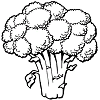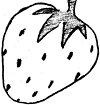

To send a message to an author, click on the author's name at the end of the article.
This Month in Ag Connection | Ag Connection - Other Issues Online
Phytophthora root and stem rot is a destructive disease of soybean. It is caused by a fungus Phytophthora sojae and infects soybean at any growth stage, from seed to maturity. Early season symptoms include seed rot and pre- and post-emergence seedling blight and damping off. The symptoms of this disease on soybean vary depending on the cultivar. Infected plant stems may appear water soaked, leaves may become chlorotic (yellow) between the veins, and plants may wilt and die, but withered leaves remain attached. Cultivars with partial resistance may appear stunted but, the plants do not typically die.
The most characteristic symptom of this disease is the formation of a dark-brown lesion on the lower stem extending up from the taproot. The lesion often reaches as high as several nodes and girdles the stem and stunts or kills the plant.
The dark brown lesion that develops on the outer tissue of the lower stem helps distinguish Phytophthora root and system rot from the stem symptoms of other diseases. Laboratory diagnosis may be necessary to distinguish the root rot phase from other common seedling blights.
This disease occurs most commonly in poorly drained soils but may also be found in those with high organic matter content. Infected plants often occur in low-lying areas of the field prone to flooding.
The fungus survives on crop residue and in the soil as spores, called as oospores. So continuous soybean production may increase disease severity. When the soil is saturated and the soil temperature is higher than 60°, oospores germinate to produce other spores; these spores swim to soybean roots, where infection occurs. From there, the pathogen colonizes the roots and stems.
Phytophthora root and stem rot is best managed by planting resistant cultivars. Rps genes have been incorporated into commercial soybean, meaning cultivars are available with complete resistance to certain races/pathotypes. Even so, the prevalence of races/pathotypes that can overcome these resistance genes continues to increase. Since populations of the pathogen can be highly diverse, as resistant cultivar will not likely be resistant to all members of the pathogen population. Partial resistance to the pathogen is also available.
Rotation to a nonhost crop may not reduce the severity of Phytophthora root and stem rot because oospores can survive in the soil for long periods. The disease is more severe in no-till fields because due to retained moisture. If tillage is considered to improve drainage, proven conservation tillage practices should be used maintain soil quality.
Seed treatment fungicides with active ingredients specific for Phytophthora species can provide some protection when there is a history of Phytophthora root and stem rot in the field, and when seed quality is poor.
Source: Dhruba Dhakal, Agronomy Specialist
This Month in Ag Connection | Ag Connection - Other Issues Online
The U.S. Food and Drug Administration (FDA) issued a "low-risk determination" for food produced from genome-edited beef cattle and their offspring. This landmark opinion applies to cattle who have had an intentional genomic alteration (IGA) introducing a short-haired or "slick" hair coat trait through a technique known as CRISPR. The FDA's review of genomic data and other information confirmed the IGA is equivalent to naturally occurring mutations and does not raise any safety concerns.
IGAs knock out an undesirable trait and replace it with a more desirable one and is then passed on naturally to offspring through conventional breeding. Cattle with this extremely short, slick-hair coat are potentially able to better withstand hot weather, decreasing the losses in production associated with heat.
"Today's (March 7, 2022) decision underscores our commitment to using a risk and science-based, data-driven process that focuses on safety to the animals containing intentional genomic alterations and safety to the people who eat the food produced by these animals," said Steven M. Solomon, D.V.M., M.P.H., director of the FDA's Center for Veterinary Medicine.
The FDA further stated the food from these cattle is the same as food from conventionally bred cattle having the same slick-hair trait. Meat products could be available for purchase by consumers as early as two years, following the use of these animals with select customers in the global market. Meanwhile, research on genome editing in animals is moving to markets outside the U.S., including Brazil, China, Argentina, Australia, and Canada, where regulatory paths are not as confining.
Source: Heather Conrow, Livestock Specialist
This Month in Ag Connection | Ag Connection - Other Issues Online
Horizon Point is an educational program of the University of Missouri, designed several years ago to make precise weather information available to Missouri farmers. Site-specific weather reports and advisories are sent to subscribers via e-mail through a free subscription.
The custom weather analysis system, Horizon Point uses weather information from the National Weather Service and the Missouri Commercial Agriculture Automated Weather Station Network. The advisories are based on weather information processed through research-based models to provide site-specific management information.
The site-specific weather information includes precipitation with both historical and forecasted (probability and quantity), temperature with both historical and forecasted (minimum and maximum), wind forecast including speed and direction in three-hour increments.
The advisories use research-based information provided by plant and animal scientists and agricultural engineers. Horizon Point's weather advisories cover crop and grain management, pest management and livestock management. Subscribers choose which advisories to receive seasonally by e-mail. For example, soil temperatures are important in the spring for planting and in autumn for fall applied fertilizer management. Soil temperature advisories would not be sent during the summer since the data is not critical to management decisions at that time.
There are several types of advisories subscribers can choose:
Various data sources are used for advisories. Some examples include: the rainfall runoff estimator is based on individual's soil type and past rainfall events into the USDA Natural Resource Conservation Service (NRCS) runoff model to estimate of the amount of rain it would take to have a runoff event for various types of ground cover. The in-bin grain drying advisory uses 3-hour increments of forecasted temperature and humidity to estimate the equilibrium moisture content of grain in a bin using natural air-drying fans.
Historical and predicted growing degree days are used to estimate weed emergence. The weed emergence alerts are linked to pictures of the emerging weed to assist in identification.
To sign up for the free Horizon Point subscription weather service, go to http://www.agebb.missouri.edu/horizonpoint. Subscribers will be prompted for an email address, password, GPS coordinates or latitude and longitude for farms/fields and predominate soil type of fields. Subscribers may manage advisories and frequency using their username and password. (see sample data in table to the below)

Source: Mary Sobba, Ag Business Specialist
This Month in Ag Connection | Ag Connection - Other Issues Online
Ornamentals
The ideal time to plant warm-season annual flowers is mid-May, after the threat of frost is past. Pansies and other cool-season flowers start to fade as the weather warms, and can be replaced with warm-season flowers like petunias or other annuals. Lantana is an annual flower that thrives in heat and drought, blooms profusely until the first frost and attracts butterflies. Milkweed and other native flowers which are food source for monarch populations, should also be planted.
Foliage on spring bulb flowers needs to photosynthesize to build up energy reserves in the bulb for next year's blooms and should not be removed until it turns brown and dies. Start pinching back chrysanthemums in May to encourage bushy growth. Pinching is a type of pruning that encourages branching on a plant. When a plant is pinched, the main stem or shoots are removed, forcing the plant to grow two new stems from the leaf nodes below the pinch or cut. Typically, 2-4 inches of a shoot is pinched. Continue pinching through mid-July.

Vegetables
Cool-season vegetables like spinach, lettuce, radishes, broccoli, and asparagus should be at the peak of harvest in May. Keep asparagus picked for continued spear production. Snow peas are usually ready by late May into June. As cool-season crop production slows, plants may be replaced with those preferring warm weather.

This is called succession planting. Mid-May is the ideal time to plant warm-season vegetable crops. Tomato plants are often a challenge for gardeners to grow due to disease and disorders. To help alleviate these issues, place straw mulch 3-4" thick around tomato plants to hold in moisture and provide disease control. Straw keeps fungus in the soil from splashing onto the lower leaves of the plant. Stake or cage tomato plants, and remove lower leaves that touch the ground. If necessary, use a fungicide containing the active ingredient chlorothalonil to control fungal disease like Septoria leaf spot or early blight.
Fruits
 Follow a spray schedule for fruits susceptible to disease and insects. Do not spray any fruit trees while in bloom. Spray trunks of peach trees and other stone fruits for peach tree borers in June. Refer to University of Missouri Extension publication, Fruit Spray Schedules for the Homeowner - G6010. Prune and train young fruit trees to eliminate poorly positioned branches and establish proper crotch angles. Thinning overloaded fruit trees will result in larger and heathier fruits at harvest time. Thinned fruits should be a hand's width apart. Enjoy the strawberry harvest in late May through mid-June. Excess strawberries can be frozen for future use.
Follow a spray schedule for fruits susceptible to disease and insects. Do not spray any fruit trees while in bloom. Spray trunks of peach trees and other stone fruits for peach tree borers in June. Refer to University of Missouri Extension publication, Fruit Spray Schedules for the Homeowner - G6010. Prune and train young fruit trees to eliminate poorly positioned branches and establish proper crotch angles. Thinning overloaded fruit trees will result in larger and heathier fruits at harvest time. Thinned fruits should be a hand's width apart. Enjoy the strawberry harvest in late May through mid-June. Excess strawberries can be frozen for future use.
Disease/Insects
Disease will be a problem for many plants during a rainy spring. Peach leaf curl is a common disease of peach and nectarine trees and is caused by the fungus Taphrina deformans. The fungus causes the growing cells at the leaf margins to multiply quickly and randomly, which results in the puckered, curled, distorted appearance. Properly timed fungicidal sprays during the dormant season (once in November and again in March) will help prevent this disease. Once a tree has peach leaf curl, fungicide sprays will not help.
Growing grapes in the Midwest can be a challenge. Black rot, a serious disease of grapes, is quite common in wet springs. To prevent it, use a fungicide spray as new shoots are 2 to 4 inches long, and again when they are 10 to 15 inches long, just before bloom, just after bloom, and when the fruit has set.
Anthracnose is a common leaf disease on shade trees in Missouri during a cool, wet spring. It is caused by fungus and development is favored by cool, wet conditions. Primary hosts include: ash, birch, elm, hickory, linden, maple, sycamore, tulip tree, walnut, and white oak. Anthracnose fungi typically create dead, brown areas forming around the leaf veins and margins. Over time these areas tend to fall out, giving the leaves a very ragged appearance. Most of the time, it is nothing to be concerned about, but fungicides are available and are most appropriate and economical for younger, newly transplanted trees that may not be able to withstand defoliation.
Source: Jennifer Schutter, Horticulture Specialist
Publishing Information
Ag Connection is published monthly for Northeast and Central areas of Missouri producers and is supported by the University of Missouri Extension, the Missouri Agricultural Experiment Station, and the MU College of Agriculture, Food and Natural Resources. Managing Editor: Mary Sobba.